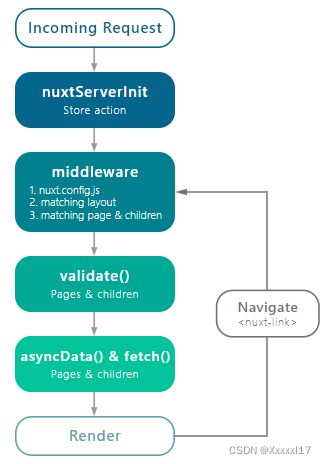NuxtJS基础应用
1 基础文档
NuxtJS官方文档
Vue SSR 指南
nuxt/i18n
2 对Nuxt的基本认知
2.1 Nuxt是什么
Next.js,一个 React 的服务端渲染应用框架。
Nuxt.js,与 Next.js 异曲同工,一个基于 Vue.js 的服务端渲染应用框架。
是一个灵活的应用框架,可以基于它初始化新项目的基础结构代码,或者在已有 Node.js 项目中使用 Nuxt.js。Nuxt.js 为 客户端/服务端 这种典型的应用架构模式提供了许多有用的特性,例如异步数据加载、中间件支持、布局支持等。
特性
| 基于 Vue.js | |
| 自动代码分层 | |
| 服务端渲染 | |
| 强大的路由功能,支持异步数据 | |
| 静态文件服务 | |
| ES2015+ 语法支持 | |
| 打包和压缩 JS 和 CSS | |
| HTML 头部标签管理 | |
| 本地开发支持热加载 | |
| 集成 ESLint | |
| 支持各种样式预处理器: SASS、LESS、 Stylus 等等 | |
| 支持 HTTP/2 推送 |
流程图
Nuxt.js 应用一个完整的服务器请求到渲染(或用户通过 切换路由渲染页面)的流程:

2.2 为什么使用Nuxt
【多页应用】:页面跳转→返回HTML
优点:首屏时间快,SEO效果好
(优:访问一个页面的时候,服务器返回一个html然后页面就会被展示出来,这个过程经历了一个http请求,请求回来了页面也就展示出来了,所以页面展示的速度非常的快)
(优:搜索引擎在做网页排名的时候需要知道网页的内容,才能给网页权重来进行网页的排名,搜索引擎可以识别html的内容,而我们网页所有的内容都放在html之中,所以SEO效果好)
【单页应用】:页面跳转→JS渲染
缺点:首屏时间稍慢,SEO(搜索引擎优化)差
(缺:单页首屏展示出来需要请求一次html,同时还需要发一个js的请求,2个请求都回来了首屏才会展示出来)
(缺:搜索引擎认识html中的内容,不认识js的内容,单页页面所有内容都是靠JS渲染生成的,搜索引擎不识别这一块的内容,它就不给你的网页一个好的排名)
3 Nuxt基础应用
3.1 相关配置了解
3.1.1 head
meta、link、script
3.1.2 router
3.1.3 plugins
3.1.4 build
3.1.5 css
3.1.6 其他更详细的移步文档
Nuxt配置
3.2 路由
3.3 请求异步数据
3.3.1 asyncData 方法
3.3.2 fetch 方法
3.4 i18n配置
流程和这篇博客类似,区别待研究:
https://blog.csdn.net/m0_52714582/article/details/119332797
1)
npm install vue-i18n
2)
i18n.nuxtjs - Lang Switcher
①middleware/i18n.js
import {
setCookie
} from "../utils/cookie"
export default ({
app,
$fullPath,
error
}) => {
try {
let langCode = 'zh_CN'
if ($fullPath.includes('/hk')) {
langCode = 'zh_HK'
}
app.i18n.setLocale(langCode)
// 客户端设置cookie--为了使客户端请求接口时带上cookie
if (!process.server) setCookie('lang', langCode)
} catch (e) {
console.error('中间件:i18n 异常', e)
error({
statusCode: 404,
message: '服务器异常!程序员拼命修复中'
})
}
}
②具体组件中执行切换语言操作:
// 切换语言 - 简繁体切换
switchLang(lang, type) {
const currentLang = this.$i18n.locale === 'zh_HK' ? 'hk' : 'cn';
if (lang === currentLang) {
location.reload();
return;
}
let path = this.$route.path;
if (lang === 'cn') {
path = path.replace('/hk', '') || '/';
window.location.replace(window.location.origin + path);
} else if (lang === 'hk') {
if (path === '/') {
path = '';
}
path = '/hk' + path;
window.location.replace(window.location.origin + path);
}
},
3)增加locales文件夹;并且创建zh_CN.json、zh_HK.json和en_US.json文件。
①data/enum/index.js
export const langType = {
enUS: 'en_US',
zhHK: 'zh_HK',
zhCN: 'zh_CN'
}
②data/i18n/locales/en_US.json
i18n/locales/zh_HK.json
i18n/locales/zh_CN.json
里面存放对应的语言内容
③data/i18n/index.js
import { langType } from '../enum'
import enUS from './locales/en_US'
import zhCN from './locales/zh_CN'
import zhHK from './locales/zh_HK'
export const locales = {
[langType.enUS]: enUS,
[langType.zhHK]: zhHK,
[langType.zhCN]: zhCN
}
④utils/i18n.js – 整合③的语言文件到这里啦
import { locales } from '../data/i18n'
/**
* 获取语言集合
*/
export function getMessages () {
return locales
}
4)配置nuxt.config.js文件
router: {
middleware: ['i18n']
},
// plugins: ['@/plugins/i18n.js'],
buildModules:['nuxt-i18n']
import { getMessages } from './utils/i18n';
i18n: {
locales: ['zh_CN', 'zh_HK', 'en_US'],
defaultLocale: 'zh_CN',
strategy: 'no_prefix',
vueI18n: {
fallbackLocale: 'zh_CN',
messages: getMessages(),
},
// detectBrowserLanguage: {
// useCookie: true,
// cookieKey: 'lang',
// // cookieCrossOrigin: true
// }
},
5)使用i18n
A.
- ①Vue组件的html里使用:
{{ $t('common.text_1') }} - ②Vue组件的js里使用(区分客户端和服务端):
客户端:this.$t('common.text_1')
服务端:app.i18n.t('common.text_1') - 纯js文件里面使用(没报错$nuxt not defined, 具体这样使用合不合适待研究):
if(process.client){
text = $nuxt.$t('common.text_2')
}
B.
获取语言:
客户端:const lang = this.$i18n.locale; // 'zh_CN / 'zh_HK / 'en_US'
服务端:const lang = app.i18n.locale; // 'zh_CN / 'zh_HK / 'en_US'
3.5 记录一些曲折
- 只在page文件夹下的vue文件使用asyncData方法才生效!子组件不生效!